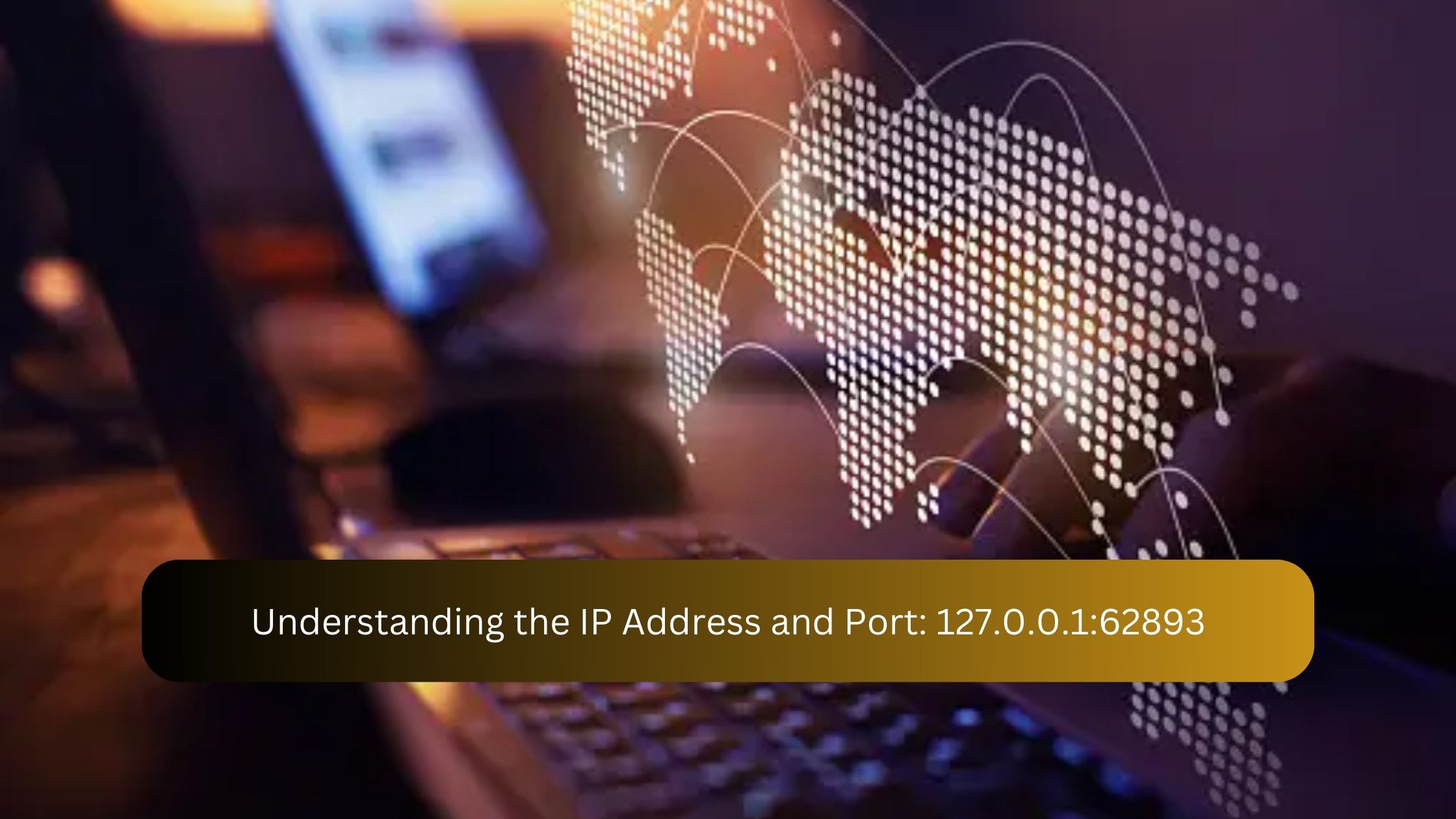With “Understanding the IP Address and Port: 127.0.0.1:62893,” you can open the door to a deeper understanding of networks by exploring the fundamentals of local communication and testing protocols.
Comprehending IP address 127.0.0.1 and port 62893 is vital for proficiently configuring and troubleshooting local networks. It acts as a special port number and loopback address for internal application testing free from network interference from outside sources.
This blog post will define 127.0.0.1:62893, describe how it works, and walk you through fixing a common error that is associated with it.
Read Also: The //Vital-Mag.Net Blog – Join Our Community!
Understanding IP Addresses
1: What is an IP Address?
An IP address is a distinct number that is linked to every device on a computer network.
2: Types of IP Addresses
IPv4:
Still extensively uses a 32-bit address format.
IPv6:
Is intended to handle IPv4 address exhaustion and use a 128-bit address structure.
3: Structure of an IP Address
Separated into the host and network sections Usually, an IPv4 address consists of four octets divided by dots.
4: Functionality of IP Addresses
Identifies sender and recipient addresses, which makes it easier for devices to communicate with one another over a network.
5: Dynamic vs. Static IP Addresses
Dynamic:
DHCP servers assign them automatically; subject to change.
Static:
Beneficial for servers and network devices, manually set up and stable.
Exploring Port 62893

1: What is Port 62893?
On a computer, port 62893 is a particular endpoint that permits data to enter and exit for network connection.
2: Role of Ports in Networking
Through ports, a single device can communicate with numerous apps at once over a network.
3: Port Number
A range of port numbers, including 62893, are utilized for various communication protocols.
4:Local vs. Public Ports
When a gadget communicates internally, it uses local ports like 62893, whereas public ports are accessible from the outside.
5:Applications Using Port 62893
Applications frequently use it for secure network connections, local testing, and development.
Read More: Ilikecoix: Shaping the Next Generation of Social Platforms
How Ports Work
1: Definition of Ports
In networking, ports are virtual endpoints that facilitate communication between devices and applications.
2: Port Numbers
A unique number, like 62893, is assigned to each port, designating the kind of communication protocol the port can support.
3: Types of Ports
Well-known Ports:
Reserved for particular services (e.g., port 443 for HTTPS and 80 for HTTP).
Registered Ports:
Overseen for particular uses by the Internet Assigned Numbers Authority (IANA).
Dynamic/Private Ports:
Client apps use this for a brief period of time.
4: Port Allocation and Management
Ports can be configured statically or dynamically based on network policies and application requirements.
5: Port Communication
Ensures that data is correctly delivered to its intended destination by facilitating bidirectional communication between programs.
Security and IP Addresses

1: IP Address Security Basics
Realizing how crucial IP address security is in thwarting potential cyber threats and unlawful access.
2: Types of IP Address Security
Network Segmentation:
Dividing networks into smaller parts and using IP addresses to control access.
Firewalls:
Installing firewalls to filter data based on IP addresses and ports for both incoming and outgoing traffic.
3: IP Address Spoofing
Methods that bad actors employ to spoof reputable IP addresses, jeopardize network security.
4: IP Address Whitelisting and Blacklisting
Whitelisting:
Granting access to resources or services to particular IP addresses.
Blacklisting:
Blocking particular IP addresses that have a history of harmful activity.
5: Best Practices for IP Address Security
Regular Updates:
Examining access controls and updating IP addresses.
Monitoring:
Keeping an eye on network activity and reviewing the use of IP addresses.
Read Also: Gpt66x – Get Instant Access!
Troubleshooting IP Issues
1: Diagnosing IP Configuration Problems
Confirming that the IP setup parameters are accurate and appropriate for the network context.
2: Checking Connectivity
Pinging devices to confirm network connectivity or utilizing network diagnostic tools to find problems with connections.
3: DNS Resolution Problems
Addressing DNS (Domain Name System) resolution problems that influence the assignment of IP addresses to domain names.
4: IP Address Conflict Resolution
Resolving disputes when the same IP address has been assigned to two devices on the same network.
5: Firewall and Security Settings
Ensuring that firewall configurations do not inadvertently block essential IP traffic or falsely identify authentic connections.
6: Updating Firmware and Drivers
Updating the drivers and firmware on network devices to fix compatibility problems that can affect IP connectivity.
7: Consulting Network Logs
Looking for trends or abnormalities in network logs that could point to underlying IP problems.
IP Address Basics
1: Development of IPv4
Using a 32-bit address format, IPv4 was the first version of the Internet Protocol to be extensively used, having been introduced in 1983.
2: Address Exhaustion Issues
As the number of internet-connected devices increased exponentially, IPv4 addresses started to run out in the late 20th century.
3: Introduction of IPv6
IPv6 was created with a 128-bit address structure that may support a significantly larger number of devices in order to overcome the constraints of IPv4.
4: Adoption Challenges
Despite IPv6’s benefits, its acceptance has been sluggish because of IPv4’s large infrastructure and compatibility problems.
5: Current Status and Transition
Global usage of IPv6 is still growing, propelled by efforts to overcome IPv4 address scarcity and future-proof network infrastructure.
Also Read: Humanilex – Explore Our Features Today!
Practical Uses of IP
1: Web Browsing and Communication
IP addresses facilitate worldwide connectivity by allowing users to interact and access websites via the internet.
2: Email and Messaging
Utilized for digital communication such as emailing and receiving instant messages.
3: File Sharing and Transfer
Peer-to-peer file sharing and data transfer across networks between devices are made easier by IP addresses.
4: Remote Access and Virtual Private Networks (VPNs)
Used to create secure connections so that resources may be accessed remotely or corporate networks can be accessed remotely.
5: Internet of Things (IoT)
IoT devices are given IP addresses, which allow for remote data gathering, control, and monitoring.
6: Online Gaming
Used to facilitate online multiplayer gaming sessions and allow for real-time communication and gameplay.
7: Cloud Computing
In order to run virtual computers in the cloud, host websites, and access cloud services, IP addresses are necessary.
IP Address Management
1: Definition and Importance
The administration of IP addresses inside a network to guarantee effective distribution and use is known as IP address management or IPAM.
2: IP Address Allocation
Techniques for allocating IP addresses, such as static IP settings, DHCP (Dynamic Host Configuration Protocol), and manual assignment.
3: Monitoring and Tracking
Instruments and methods for measuring changes, keeping an eye on IP address utilization, and making sure addresses are not overused.
4: IP Address Planning
Techniques for subnetting, addressing systems, and IP address allocation planning that maximize network scalability and performance.
5: Security and Access Control
Putting in place security measures to prevent unwanted access, such as firewall rules, IP address whitelisting, and blacklisting.
6: Documentation and Documentation
For compliance and troubleshooting purposes, it is crucial to keep precise records of IP address assignments, configurations, and network architecture.
Understanding Networking Protocols
1: Definition and Purpose
The rules and practices that control how devices interact and exchange data via networks are known as networking protocols.
2: Types of Networking Protocols
TCP/IP:
TCP (Transmission Control Protocol) and IP (Internet Protocol) comprise the core protocol stack for Internet communication.
UDP:
Lightweight communication that is appropriate for real-time applications but does not ensure delivery.
HTTP/HTTPS:
Protocols for safe online communication and web browsing.
FTP/SFTP:
Used with FTP (File Transfer Protocol) and its secure counterpart SFTP (SSH File Transfer Protocol) for file transfers across networks.
3: Layered Protocol Models
OSI Model:
A seven-layer model that describes how networking works, from application interaction to physical transmission.
TCP/IP Model:
Four levels comprise the simplified model: the Application, Transport, Internet, and Link layers.
4: Protocol Operations
Addressing and Routing:
Routing packets between networks and addressing methods, such as IP addresses, are handled by protocols.
Data Integrity:
Make sure data arrives undamaged by utilizing error-correcting and detection systems.
Session Management:
To ensure dependable communication between devices, create and maintain sessions.
5: Emerging Protocols and Technologies
IPv6:
Address exhaustion problems with the next-generation IP addressing scheme, which will replace IPv4.
IoT Protocols:
MQTT, CoAP, and other protocols are tailored for IoT devices with low power and bandwidth.
Blockchain Protocols:
Blockchain-based distributed ledger technology, such as those seen in Ethereum smart contracts or Bitcoin.
Frequently Asked Questions FAQs:
Q.1 What is 127.0.0.1:62893 used for?
In order to ensure the proper operation of apps on a single device during internal testing and debugging without interference from an external network, 127.0.0.1:62893 is usually utilized as a loopback address and port number.
Q.2 Is 127.0.0.1:62893 safe to expose publicly?
It is not safe to expose 127.0.0.1:62893 to the public as it is meant only for local testing and doing so could put users’ security at risk from unknown vulnerabilities and unwanted access.
Q.3 How does 127.0.0.1:62893 differ from other ports?
Unlike other ports, 127.0.0.1:62893 is reserved for local testing and communication only within a single device, guaranteeing that data is kept separate from external networks and programs.
Q.4 Why is 127.0.0.1 commonly used in IP addresses?
Since it is the loopback address and enables device-to-device communication for testing and debugging without touching other networks, 127.0.0.1 is frequently used in IP addresses.
Q.5 How do I check if port 62893 is open or closed?
Network diagnostic tools such as Netstat or Telnet can be used to determine whether port 62893 is open or closed and whether it is actively listening for connections.
Q.6 What is the difference between 127.0.0.1:62893 and 127.0.0.1:8080?
The port numbers 127.0.0.1:62893 and 127.0.0.1:8080 differ from one another; each is a distinct endpoint for local development or testing, and separate ports are usually assigned to different programs for specific or concurrent uses.
Q.7 Is 127.0.0.1:62893 part of the TCP/IP protocol suite?
No, 127.0.0.1:62893 is a port number inside the TCP/IP protocol suite that is used for internal communication on a device and local testing, not a part of the protocol suite itself.
Conclusion:
It is essential for network managers and developers alike to comprehend the IP address and port combination 127.0.0.1:62893.
It stands for a loopback address, which enables internal device communication for testing and troubleshooting.
In particular, port 62893 shows how several ports can be used by applications to control many connections and features on the same system at the same time.
Although necessary for local testing, these configurations should not be made public owing to security concerns.



